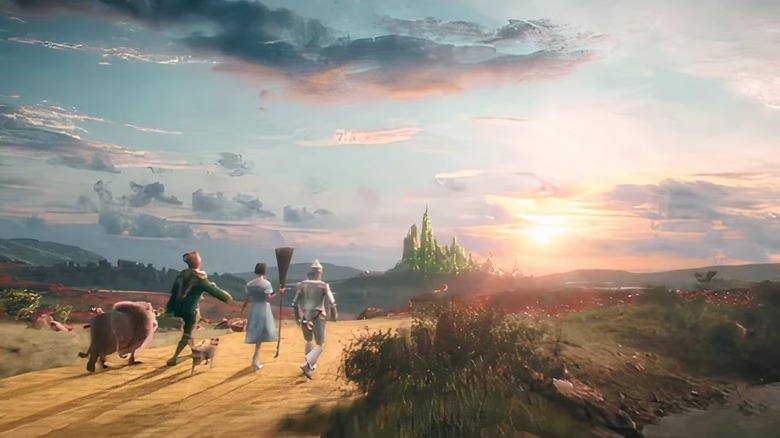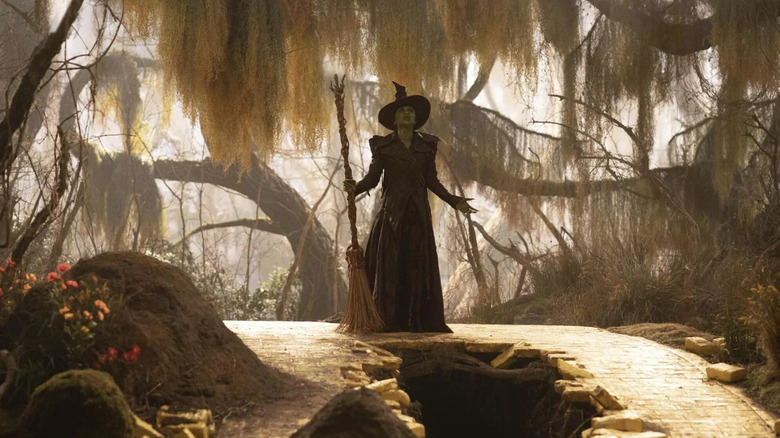Wicked: For Good Changed The Meaning Of Oz's Yellow Brick Road Into Something Dark
Hop off your broomstick and put down the Grimmerie if you haven't seen "Wicked: For Good" yet. Spoilers ahead!
In the 1939 film "The Wizard of Oz," the yellow brick road traversed by Dorothy (Judy Garland), her dog Toto, and her new friends in Oz is a cheerful, charming part of the movie (which also helps show off the film's stunning use of Technicolor). In "Wicked: For Good," it takes on a much more sinister meaning because it represents forced labor and oppression.
As production designer Nathan Crowley told RadioTimes.com in an exclusive interview, crafting this iconic pathway for Jon M. Chu's two-part adaptation of the Broadway musical "Wicked" — which itself is a take on "The Wizard of Oz" — took a strange turn for the second film, "Wicked: For Good." As Crowley put it, "The Yellow Brick Road is slightly harder because we are telling a different story with [it]. We're telling you that it's a form of oppression, not joy. The Wizard is using it to cut down the forest of Oz. And so we have to tell that story."
This is actually on display in the film's opening moments, where we watch as Ozian officials force animals — animals that have been stripped of their ability to speak and enslaved on the orders of the Wizard, played by Jeff Goldblum — to build the road itself before the Wicked Witch of the West, Elphaba Thropp (Cynthia Erivo), intervenes and frees the once powerful beasts. The treatment of animals in "Wicked" is a pretty clear allegory for fascism and slavery, and unfortunately for the Yellow Brick Road, this beloved movie structure is a big part of that.
The Yellow Brick Road doesn't feel as sunny or cheerful in Wicked: For Good
As Nathan Crowley pointed out in this interview, the Yellow Brick Road didn't just spring up overnight; it was built with blood and toil by animals and Munchkins. "We also have to tell the story of how Oz made the Yellow Brick Road, which is, you know, the Munchkin story — they were farming all the colors of the rainbow, but now they're only farming yellow tulips," he explained. "So for this film, we grew a million yellow tulips off in another field, and then we showed the process of using that yellow dye to make the bricks in Munchkinland."
The whole conceit of Oz is that it's fantastically colorful, so as Crowley also pointed out, the fact that the road is one singular color also represents the ways in which the "lesser" people of Oz (again, Munchkins and animals, primarily) are so oppressed. "They're losing their color and they're losing the rainbow, and so it has big consequences, that road," he mused. "And that's what I love about 'Wicked' — telling you that story, rather than the story we all know."
From a practical production standpoint, though, Crowley said that pinpointing the "right" shade of yellow was tricky because different light conditions — natural light, stage lights, and so on, depending on where they were filming at any given time — changed how it looked. "We have to use different glazes and different yellows, and it's a lot of trial and error," he revealed. "We sat and looked at an enormous amount of yellows!"
The animals of Oz use a portion of the Yellow Brick Road as an escape hatch in Wicked: For Good
As Elphaba observes the sweeping fascism make its way through Oz — courtesy of the Wizard and propaganda spread by his right-hand woman, Madame Morrible (Michelle Yeoh) — she notices a conspicuous hole in the Yellow Brick Road from her vantage point in the sky and drops down to investigate. When she gets there, she sees animals fleeing Oz en masse, including her beloved nanny Dulcibear (voiced by Sharon D. Clarke), and they all tell her that there's no longer any hope and they can't possibly stay in Oz. Despite Elphaba's pleas, which include a new song written by Stephen Schwartz (the man behind the Broadway musical) called "No Place Like Home," the animals aren't swayed and use this hole in the road as a sort of Underground Railroad to go beyond Oz and live safely and freely.
Throughout "Wicked: For Good," we watch as various evil forces oppress animals and Munchkins in the cruelest and most casual ways — for God's sake, the Wizard has a whole hidden room of caged animals just off of his expansive magical quarters — but thankfully, when all is said and done, the animals are welcomed back to Oz. After Elphaba fakes her death and flees, her former best friend, Glinda (Ariana Grande-Butera), tells animals, Munchkins, and humans alike that Oz is for everyone. Still, it's heartbreaking to watch their treatment until that happy ending, and it really does paint the Yellow Brick Road in a whole new light.
"Wicked: For Good" is in theaters now.


